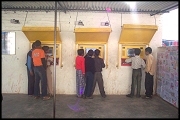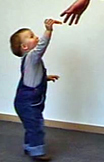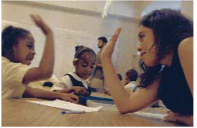 Children in Remote Villages in India Teaching Themselves to use Computers Instinctively – with No Help from Adults
Children in Remote Villages in India Teaching Themselves to use Computers Instinctively – with No Help from Adults
An IT engineer in India was gazing out his office window at the poverty-ridden shanty town located just outside the walls of his sleek hi-tech corporate compound. This irony led to inspiration. Computer skills offer a better chance at success for these poor kids.
The BBC reports, “He decided it was time to break a hole in the wall and give the children outside a chance to see what a computer was. He cut a hole and hooked one up. What happened next amazed him. They taught themselves how to use it.”
The article gives fascinating detail on how that occurred.
Innovative kid-only computer kiosks (built to keep large adult hands out) are now being installed in the village squares of other impoverished areas.
Since its inception in 1999, the
Hole-in-the-Wall project has grown from a single computer at Kalkaji, New Delhi, to more than a hundred computers at various locations across India and abroad. For the children, it is an extension of their playground where they can play together, teach each other new things and, more importantly, just be themselves. World leaders, like the president of Afghanistan, have come to watch them play on the computers.
The really interesting twist is, no one teaches the kids how to use the technology. They teach themselves. “The driving force behind Hole-in-the-Wall is the the concept of Minimally Invasive Education which is truly path breaking,” reads their Web site. Observing the children at the kiosks for four years has shown “children could learn on their own, something not many people would have imagined.”
Editor’s note: Some families in the U.S. have “imagined” it and they called it Unschooling… a type of homeschooling that is gaining momentum. It is also called natural learning or child-led learning. Approximately 100,000 kids in the U.S. are in families that practice this philosophy… including my own! — Geri
 Quality production and labor practices are being adopted by global companies attracted to markets that adhere to higher standards. Europe’s demands for fruit without pesticides was one of the factors that led to a quality certification for 1,200 growers in Brazil. The standards have been a win-win situation for growers, laborers, the economy and consumers. Brazil’s guarantee of quality produce, grown with respect for the environment, work conditions and health, has led to increases in exports;— and employment — since its implementation four years ago. Additionally, a decrease of 40 percent in the use of fertilizers and of 25 percent in the use of pesticides created “a positive influence on their production costs.”
Quality production and labor practices are being adopted by global companies attracted to markets that adhere to higher standards. Europe’s demands for fruit without pesticides was one of the factors that led to a quality certification for 1,200 growers in Brazil. The standards have been a win-win situation for growers, laborers, the economy and consumers. Brazil’s guarantee of quality produce, grown with respect for the environment, work conditions and health, has led to increases in exports;— and employment — since its implementation four years ago. Additionally, a decrease of 40 percent in the use of fertilizers and of 25 percent in the use of pesticides created “a positive influence on their production costs.”























 What is human nature? Are we basically good, evil, or a little of both? Philosophers have debated this throughout the ages, but today science delivers some definitive news. Humans are naturally altruistic.
What is human nature? Are we basically good, evil, or a little of both? Philosophers have debated this throughout the ages, but today science delivers some definitive news. Humans are naturally altruistic.







